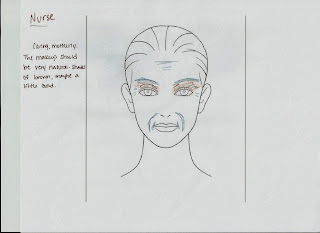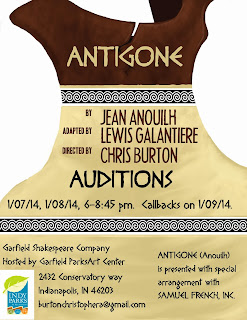Each character will get a coating of adhesive and oatmeal (at this point, most likely) to frame the face and outline major features - cheek bones, eyebrows, jaw lines, etc. We will simulate age by adding "age lines" with the stone effect, highlighting smile lines, eyebrow furrows, and the like. Each character will also have a specific color of shadow around the eye to simulate a kind of marble, gem, or stone. Because of the Chorus's unique position in the show, we plan to have the Chorus in full stone face.
Antigone
Antigone's makeup will be shades of blue. This will probably be closest in color to the set, and represents Tragedy.
Ismene
Ismene's color will be green. Antigone starts the show wearing Ismene's beautiful green dress. Green also represents purity and innocence.
Eurydice
Eurydice will have dark colors around her eyes, probably similar in color to the stone work. She is one of the oldest characters, and will have stone work around the eyes, mouth, and forehead to represent age.
Nurse
The Nurse is Antigone and Ismene's primary caregiver. Her makeup will be motherly and natural - reds and browns, and possibly gold.
Page
The Page, Creon's servant, is the youngest character in the play. Makeup will reflect flesh tones in the midst of very minimal stone work.
Chorus

The Chorus, our trusty narrator and guide through the world of the play, will closely represent an antique statue. She will have full stone face, with highlights and low lights in the stone work as to avoid washing out features.
Stone Work Template - Age
Older characters, like Creon, Eurydice, and the Nurse, will have more "intricate" stone work, as if the stone from whence they came is taking over the body.
Stone Work Template - Youth
Younger characters, like Antigone, the Page, Ismene, and the Messenger, will have less stone work, and brighter colors around the eyes.










